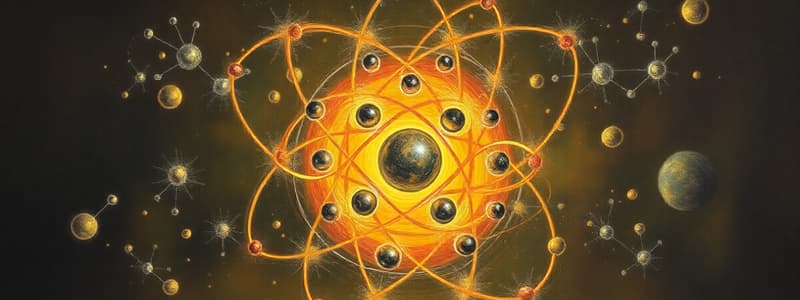Podcast
Questions and Answers
What are the three types of subatomic particles?
What are the three types of subatomic particles?
Electrons, protons, and neutrons
Electrons are positively charged.
Electrons are positively charged.
False (B)
Neutrons have a positive charge.
Neutrons have a positive charge.
False (B)
What is the mass of a proton relative to the mass of a hydrogen atom?
What is the mass of a proton relative to the mass of a hydrogen atom?
What is the location of the positively charged nucleus in an atom?
What is the location of the positively charged nucleus in an atom?
What are the special orbits called where electrons revolve around the nucleus?
What are the special orbits called where electrons revolve around the nucleus?
What are the other names for the electron orbits?
What are the other names for the electron orbits?
Electrons radiate energy while revolving in their orbits.
Electrons radiate energy while revolving in their orbits.
The first shell can hold a maximum of ______ electrons.
The first shell can hold a maximum of ______ electrons.
The second shell can hold a maximum of ______ electrons.
The second shell can hold a maximum of ______ electrons.
What is the relationship between the number of protons and the number of electrons in a neutral atom?
What is the relationship between the number of protons and the number of electrons in a neutral atom?
What is the term used for atoms that have gained or lost electrons, resulting in a net charge?
What is the term used for atoms that have gained or lost electrons, resulting in a net charge?
What is the formula for calculating the mass number or atomic mass of an atom?
What is the formula for calculating the mass number or atomic mass of an atom?
How do you calculate the number of neutrons in an atom?
How do you calculate the number of neutrons in an atom?
What is the relationship between the atomic number, the number of protons, and the number of electrons in a neutral atom?
What is the relationship between the atomic number, the number of protons, and the number of electrons in a neutral atom?
Flashcards
Atom's Net Charge
Atom's Net Charge
The total positive charge of the atom is equal to the total negative charge of the atom. In other words, the number of protons (positive charge) is equal to the number of electrons (negative charge).
Proton
Proton
A particle with a positive charge found in the nucleus of an atom.
Electron
Electron
A particle with a negative charge that orbits the nucleus of an atom.
Ion
Ion
Signup and view all the flashcards
Valence Shell
Valence Shell
Signup and view all the flashcards
Atomic Number
Atomic Number
Signup and view all the flashcards
Mass Number
Mass Number
Signup and view all the flashcards
Electron Shell
Electron Shell
Signup and view all the flashcards
Electron Shell Capacity
Electron Shell Capacity
Signup and view all the flashcards
Electronic Configuration
Electronic Configuration
Signup and view all the flashcards
Study Notes
Atomic Structure Objectives
- Study the structure of atoms and the electronic structures of the first 20 elements in the periodic table.
Atomic Structure Components
- Atoms are composed of three subatomic particles: electrons, protons, and neutrons.
- Electrons have a negative charge.
- Protons have a positive charge.
- Neutrons have no charge.
- The mass of an electron is significantly less than that of a proton or neutron. A proton or neutron is about 2000 times more massive than an electron.
Atomic Structure Charges
- A neutral atom has an equal number of electrons and protons.
- Ions are formed when atoms gain or lose electrons, acquiring a net positive or negative charge.
Atomic Structure Nuclei
- The nucleus is at the center of the atom.
- It contains protons and neutrons.
- The mass of an atom is primarily concentrated in its nucleus.
Atomic Structure Orbits/Energy Levels
- Electrons orbit the nucleus in specific energy levels (or shells).
- The shells are represented by letters (K, L, M, N...) or numbers (1, 2, 3, 4...).
- Each shell can hold a specific number of electrons.
Electron Shell Capacity
- The first shell (K) can hold 2 electrons.
- The second shell (L) can hold 8 electrons.
- The third shell (M) can hold 8 electrons.
- The fourth shell (N) can hold 18 electrons.
Mass Number/Atomic Number/Neutrons
- The mass number of an atom equals the number of protons plus the number of neutrons in the atom's nucleus.
- The atomic number of an atom is equal to the number of protons in its nucleus.
- The number of neutrons in an atom is calculated by subtracting the atomic number from the mass number.
Periodic Table Basics
- The periodic table organizes elements by atomic number and recurring chemical properties.
- The periodic table is structured in columns and rows (groups and periods).
Studying That Suits You
Use AI to generate personalized quizzes and flashcards to suit your learning preferences.



